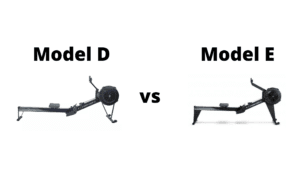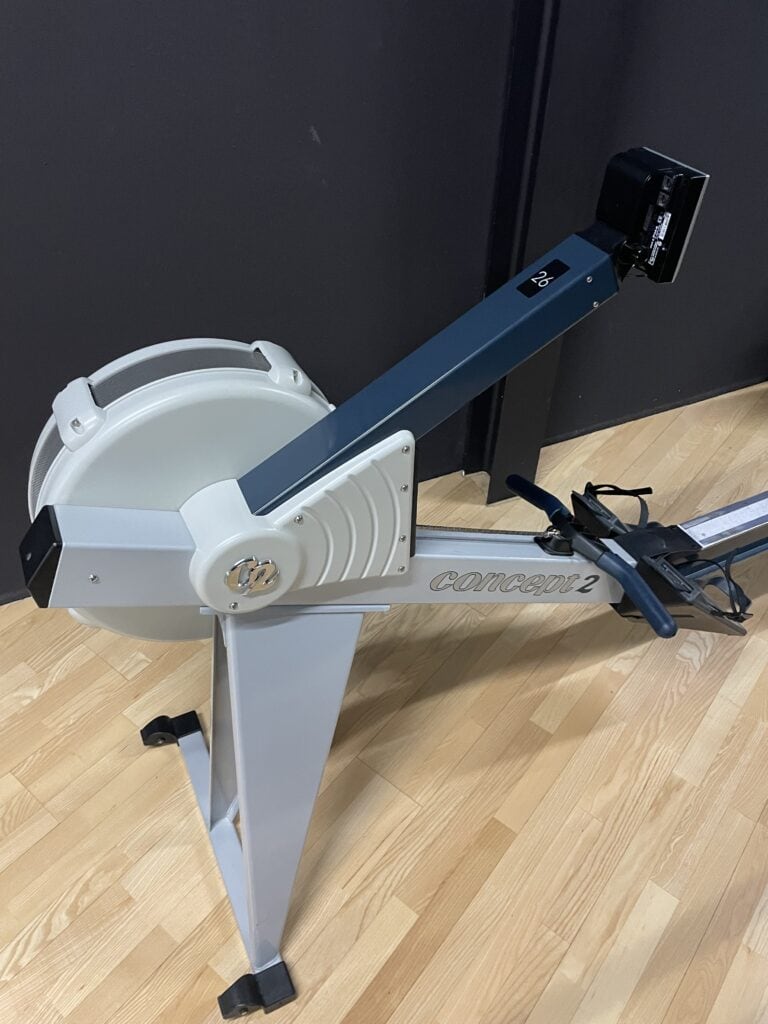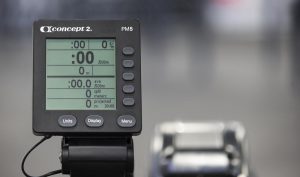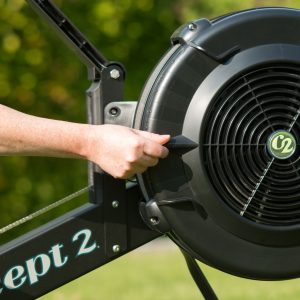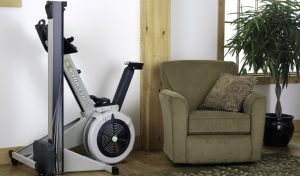This guide compares the Concept2 Model D vs Concept2 Model E.
Model E has a taller seat, is heavier than the Model D and has a better finish.
Another difference is that the Model E has a robust welded steel construction throughout unlike the Model D.
While both Model D and Model E are functionally equal, some features set them apart.
To help you select the right rower, here is the in-depth comparison:
To compare the two models, let us look at each feature one at a time.
Model D
Check PriceThe seat on the Model E is higher off the ground. This makes it as tall as a regular chair. The seat height is 6 inches more than model D. So people with physical disabilities, back problems and the elderly will find Model E rower easier to sit on.
The arm attached to the PM5 performance monitor on Model D is made of ABS plastic. It has the following features:
The aluminum arm attached to the Model E is fixed and bigger in length. Apart from changing the viewing angle of the monitor, you can’t make other adjustments as in Model D. This makes model D a slightly better choice.
Model E
Check PriceThe Model D has aluminum front legs and steel rear legs. On the other hand, the Model E has welded steel construction throughout. It is common knowledge that steel has more structural strength than aluminum. Steel is strong and less likely to warp, deform or bend underweight, force or heat. However, steel has a 2.5 times higher density than aluminum, so it is heavier than aluminum.
The Model E has a better finish as compared to the Model D. The latter has a single powder coat while the former has a double powder coat with a glossy finish.
This makes the Model E more durable. But don’t get me wrong, the Model D is capable of lasting as long as a decade. But the Model E is slightly better. This is the reason Model E is better suited for commercial use in gyms and fitness clubs.
Both models have a nickel-plated steel chain. However, the Model E has a fully enclosed chain housing while the Model D has a partially enclosed chain housing.
The Model E is harder to store since it is bigger and doesn’t have a foldable monitor arm. Model D can also be transported rather easily unlike the Model E. Model E has steel construction throughout, which makes it heavier than the Model D, which has aluminum front legs.
Model E is a couple of hundred bucks more expensive.
A few years ago, the Model D used to come with the PM3 monitor and the Model E with the PM4. Now both models have the superior PM5 monitor, which is considered the best performance monitor.
The features mentioned above are the only differences between the two models. If you want to make a decision, ask yourself the following key questions:
If you answered yes to all the above questions, you should go for the Model E. Otherwise, model D is the one for you.
Apart from the things mentioned above, everything else in the Model D and the Model E is the same. If you don’t have any problems sitting on a lower-height seat, it’s best to go with the Model D.
Both rowers have remarkable build quality. As mentioned earlier, the Model E is made from welded steel. In Model D, the front legs are aluminum and the rear legs are steel. They both are used in commercial settings, so you don’t have to worry about durability once you buy either the Model D or the Model E. Many customers have reported that this rower holds its value even after ten years of use.
Both machines use air resistance to create tension. The metal flywheel spins, it has to push through the air which creates resistance. When it comes to resistance, there is no difference in the rowers. Although the harder you row, the more resistance you can have; the rowers also have adjustable resistance. You can change the damper setting to tweak the resistance higher or lower.
Since the resistance is variable, the rowers are great for high-intensity interval training workouts (HIIT), in which you engage in short intense bursts of workout followed by shorter rest periods. HIIT focuses on the anaerobic zone, where you workout despite being out of breath. Such workouts burn more calories, strengthen your heart and improve your metabolism.
Since the rowers use air resistance, there is some level of noise in both rowers. You can hear the ‘whooshing’ sound with each stroke. But it isn’t hard on the ears and you won’t need to wear headphones. The sound is better than that of a treadmill and is a bit soothing.
However, if you have someone in the same room, they may be disturbed by the noise and won’t be able to watch tv or focus on anything. If you row at lower intensity levels though, the sound from the TV is audible. But if you row at moderate or harder levels, you won’t be able to hear the audio clearly.
Both rower models use air resistance. Air resistance is a bit noisy as compared to water or magnetic resistance. The upside, however, is that the resistance increases as you row harder. So you can get the feeling of rowing on a river.
Olympians and professional rowers prefer air resistance because of this characteristic.
You don’t need to worry about the type of resistance when buying a Concept2 rower. These rowers are superior to almost every other rowing machine because of their performance and ability to hold value over years of use.
The company created the first ever rowing machine in 1981 to help athletes with their training. Since then, they have been the #1 brand in the rowing industry.
The damper settings on the Model D and E are the same. There are 10 resistance levels you can choose from the damper. The higher the damper setting, the more air is pushed through the flywheel. Hence, the “feel” of the rowing stroke is changed.
Note that the real measure of resistance is the drag factor, not the numbers you see on the outside of the machine. To see the drag factor, go to “more options” on the display and then click on “display drag factor”.
Drag factor is different from one person to the other. But typically it ranges anywhere from 110 to 130 for most people. You can use the damper settings and the drag factor to increase resistance. It is very much like shifting gears on a bike. The higher the gear, the harder it is to pull, but it produces more power (watts).
If you are a beginner it is best to keep the damper setting below 5 and work at a low drag factor.
Also note that if you want to up the resistance for strength training, it isn’t advisable to crank the damper setting to the highest 10. This is because it puts an undue amount of pressure and strain on your back. In fact, most rowers including Olympic-level rowers row at levels 4 to 6 to put the level in the middle of the flywheel.
So it is important to remember that a higher damper setting doesn’t lead to faster results. Olympic gold medalists like Hamish Bond and Eric Murray practice indoor rowing at 5-6 damper settings.
The focus should be on using the proper rowing technique, length of the rowing stroke and improving the speed of your stroke. The faster you row, the lower your split time gets.
Here is a video of the 2k world record holder Josh Dunkley Smith rowing at damper setting 5.
In the end, the resistance is not created by the rowing machine. The resistance is created when you row harder and faster.
Both models have the same performance monitor, PM5. Although it doesn’t look high-tech, it functions like one. It is regarded as the best performance monitor in the rowing community. It tracks time, strokes per minute, calories burnt, watts, 500m split and more. It has various functions with various benefits: they allow you to instantly start rowing, practice a preset workout, create a personalized workout or learn the proper form with an interactive game.
The PM5 monitor has ANT+ and Bluetooth technology, using which it can pair with compatible heart rate monitors. Heart rate monitoring is one of the best ways to track and improve your performance. It allows you to become aware of your heart rate zone and train in the right zone. This helps you get more out of each workout.
On top of that, the PM5 monitor connects with various smartphone apps to help you visualize your performance. It is crazy how user-friendly and technologically advanced the PM5 is. You can integrate your performance data with smartphone apps and the website. If you are a beginner, there is a wealth of information you can find on their official website.
The rowers can also connect with a USB drive and store months of your progress. You can see “before and after” performance graphs to see how far you have come after a few months of consistent workout.
Both models are long and need an adequate amount of space. However, they can be disassembled for compact storage. You can separate the flywheel from the monorail and have the monorail stand vertically with the flywheel part resting on it. This reduces the size to 25” x 33” x 54”.
The rowers are built like a tank and will surprise you with their standard of performance. Every rowing stroke is smooth and the seat glides quietly as you row. You can row harder to make it more challenging or tweak the damper settings. Air resistance simulates the experience of rowing on water, giving you a low-impact, full-body workout.
Its performance is remarkable and supported by the fact that Olympic athletes, Army veterans and fitness experts around the world use this rower. The damper settings let you instantly change the intensity of your workout. There are ten resistance levels, so no matter what your fitness level is, you can get an amazing workout that leaves you refreshed.
Both models have sufficient padding on the seat and an anti-slip handle. The comfort level of seats is rather subjective.
So there is a good chance that you may need to buy a seat cushion. The Model E, however, is more comfortable for people with back issues or physical disabilities because of its higher seat. If you don’t have these issues, the Model D is equally comfortable.
The handle is comfortable and easy to hold for extended periods. However, a few users mentioned how the handle felt a little too firm and their hands started aching after using it for some time. If you do encounter this issue, wearing workout gloves can solve the problem.
The foot plates are excellent on both rowers. One can easily adjust them according to their shoe size and velcro straps keep feet secured in place. You can row even barefooted on this rower because of the quality foot plates.
Both models are easy to set up. You need just eight screws to install the front legs into the unit. All tools for assembly provided in the package.
It is remarkable how such a technologically advanced and sophisticated rower can be assembled and disassembled in a few minutes.
Here is a detailed video showing the assembly of Concept2 Model E Rowing Machine:
Both models can support a staggering 500 pounds of weight. The rowers are made like a tank, so there is nothing they can’t tackle.
Both models are covered by the same warranty. The company offers a five-year warranty on the frame and a two-year warranty on the parts.
A long-term warranty is a nice-to-have, although Concept2 rowing machines are known to last many years, sometimes even decades.
Apart from the warranty, you also get a 30-day money back guarantee in case the product doesn’t meet your preferences.
You can check the complete warranty information here.
The short answer is, because of their superior quality. The company built the first rowing machine on the planet, so no wonder they are the best.
Their rowing machines are seen in almost all gyms and fitness clubs around the world. Olympic athletes and army veterans such as Jocko Willink admire this engineering masterpiece.
Here is why the Model E costs more.
The major difference is the seat height. Its seat is 6 inches higher off the ground.
It has welded steel construction throughout, while the Model D has both steel and aluminum construction.
It has a better finish, which means it is slightly more resistant to scratches and keeps its visual appeal better.
The fact that it has a more rugged construction and a better finish makes it well-suited for commercial settings.
Overall, the difference between the two models isn’t huge.
So if you want the minor upgrades or the more seat height, go for the Model E. Otherwise, Model D is equally efficient.
Neither of the rowers is loud, but sometimes your neighbors on the lower floor will be able to feel a a slight vibrating sensation which isn't really problematic.
However, if you want the rowers to be 'noise free', just follow this simple DIY method:
1. Purchased a 25 X 12 inch piece of extremely dense and solid one inch thick closed cell foam rubber.
2. Put it on the floor underneath the flywheel section.
3. Place a same size piece of heavy duty 3/8 inch thick gym equipment mat to support the weight of the machine.
4. Use the same padding measuring 22 x 11 inches under the rear of the monorail.
This DIY padding system will dampen and isolate any noise coming from the rower.
The core difference is in the seat height of Model E. The seat is 6 inches higher off the ground which helps users with back or joint issues or limited mobility. Apart from seat height, the Model E has a better finish - it has a double powder coat with a glossy finish. The Model E is larger in size and has a fixed monitor arm - two factors that make it harder to store.
The noise level on both rowers is comparable. None of them is annoying when it comes to noise. If you want to eliminate the noise, put thick and dense foam rubber under the flywheel and the monorail. Then add a gym mat on top under both areas. This arrangement ensures your neighbors don't hear anything at all while you're rowing.
The maintenance in both Model D and E is the same. You need to wipe the monorail daily, lubricate the chain after every 50 hours of use and every 250 hours of use, you need to inspect the chain for stiff links, wear and tear and do other maintenance checks.
The in-depth comparison shows that both rowers are more similar than different. The Model E has a couple things better than the Model D, but it is also heavy and hard to stow away.
One of the main reasons people buy the Model E is because of its taller seat.
But no matter which one you buy, it is going to last more than a decade. This is what Concept2 rowers are known for.
So now you know what separates the two!
